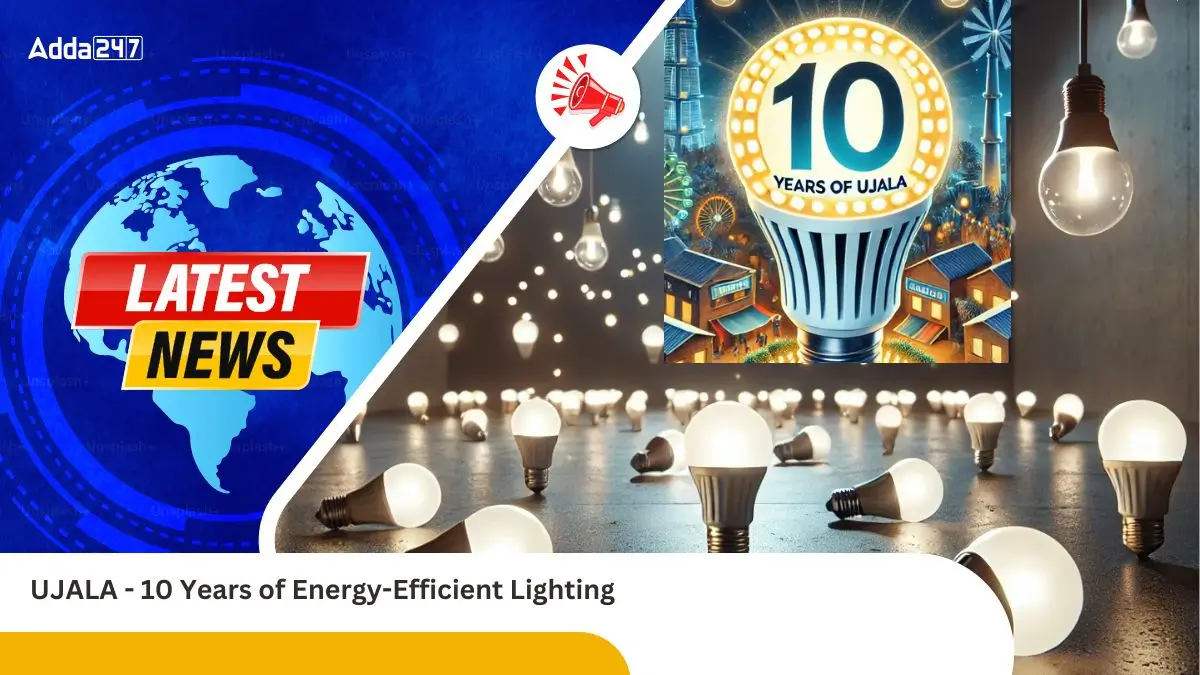The UJALA (Unnat Jyoti by Affordable LEDs for All) scheme, launched by Prime Minister Narendra Modi on 5th January 2015, has completed a decade of impactful service to the nation. This initiative, originally launched as the Domestic Efficient Lighting Programme (DELP), revolutionized India’s domestic lighting sector by providing affordable, energy-efficient LED bulbs, tube lights, and fans to households across the country. It has contributed to not only lowering energy consumption but also reducing carbon emissions, making India a global leader in energy-efficient lighting. The UJALA scheme, along with the Street Lighting National Programme (SLNP), has significantly impacted the country’s energy efficiency, economic savings, and environmental sustainability.
Key Highlights of UJALA Scheme
- Launch Date: 5th January 2015.
- Vision: To promote affordable energy-efficient lighting in Indian homes, reduce electricity consumption, and contribute to environmental sustainability.
- Partnerships: The scheme is jointly executed by Energy Efficiency Services Limited (EESL) and DISCOMs under the Ministry of Power.
- Scope: Distribution of LED bulbs, tube lights, and fans at affordable prices across India.
- Objective: To reduce energy consumption, lower household electricity bills, and decrease carbon emissions.
- Impact: As of 6th January 2025, the UJALA scheme has distributed 36.87 crore LED bulbs, leading to savings of ₹19,153 crore annually.
Illuminating Efficiency : Need for UJALA
Before UJALA, traditional lighting systems, such as incandescent bulbs (ICLs) and compact fluorescent lamps (CFLs), were widely used but consumed large amounts of electricity and were expensive for consumers. A significant barrier to the adoption of LED bulbs was their high initial cost, which was around ₹450-500 per bulb in 2014, compared to ₹100-150 for CFLs and ₹10-15 for ICLs. To overcome this challenge, the UJALA scheme aimed to provide LED bulbs at significantly reduced rates, thus facilitating widespread adoption and enabling consumers to save on energy costs.
- Energy Efficiency: A 7W LED bulb provides the same lighting as a 14W CFL and a 60W ICL, saving almost 90% of energy compared to ICLs and 50% compared to CFLs.
- Affordability: UJALA enabled consumers to purchase LED bulbs for ₹70, LED tube lights for ₹220, and energy-efficient fans for ₹1,110.
- Cost Savings: An LED bulb uses only 1 unit of electricity for 140 hours, compared to 2 units for a CFL and 9 units for an ICL. This results in a significant reduction in electricity costs.
UJALA’s Decade of Impact
Since its launch, the UJALA scheme has had transformative effects on India’s energy sector and consumer habits.
- Distribution: 36.87 crore LED bulbs have been distributed across India by 2025.
- Economic Savings: The scheme has resulted in an annual saving of ₹19,153 crore in electricity costs for households.
- Environmental Impact: The widespread adoption of LED lighting has contributed to reducing the nation’s carbon footprint.
- Market Transformation: The UJALA scheme has successfully fostered the growth of the LED market, leading to 407.92 crore LED bulbs sold in India.
Street Lighting National Programmes (SLNP)
- Implementation: The program was implemented by EESL in collaboration with Urban Local Bodies (ULBs), Municipal Bodies, and Gram Panchayats (GPs).
- Business Model: EESL handles the upfront costs and recoups the investment through monthly or quarterly payments made by municipalities.
- Achievements: By January 2025, over 1.34 crore LED streetlights have been installed, saving 9,001 million units (MUs) of electricity annually.
Energy Savings and Environmental Benefits
- Reduction in peak demand by over 1,500 MW.
- Decrease in CO₂ emissions by 6.2 million tonnes annually.
Impact and Conclusion
The UJALA and SLNP schemes have had a transformative effect on India’s energy consumption patterns and environmental sustainability:
- Economic Impact: UJALA has reduced household electricity bills, contributing to significant savings for Indian families.
- Environmental Sustainability: Both UJALA and SLNP have played a major role in reducing the nation’s carbon footprint, supporting India’s climate change mitigation efforts.
- Market Shift: UJALA’s success in making LED technology affordable has transformed the lighting market in India, setting a global example of energy efficiency.
The UJALA scheme, alongside SLNP, reflects India’s commitment to sustainable development and energy efficiency. These programs not only foster economic growth but also contribute significantly to global environmental goals, providing a model for energy-efficient initiatives worldwide.
| Summary/Static | Details |
| Why in the news? | UJALA – 10 Years of Energy-Efficient Lighting |
| Launch Date | 5th January 2015 |
| Objective | Promote affordable, energy-efficient lighting and reduce carbon emissions |
| Implementing Agencies | Energy Efficiency Services Limited (EESL), DISCOMs, Ministry of Power |
| Key Products | LED bulbs, LED tube lights, energy-efficient fans |
| Cost of Products |
₹70 per LED bulb, ₹220 per tube light, ₹1,110 per fan
|
| Energy Efficiency |
LED bulbs consume 1 unit for 140 hours vs. CFL (2 units) and ICL (9 units)
|
| Total Distribution |
36.87 crore LED bulbs distributed by 2025
|
| Annual Savings |
₹19,153 crore in electricity costs
|
| Environmental Impact |
Reduction in carbon emissions and energy consumption
|
| Street Lighting National Programme |
1.34 crore LED streetlights installed, 9,001 MUs energy saved annually
|
| Energy Savings (SLNP) |
Reduction in peak demand by 1,500 MW, 6.2 million tonnes of CO₂ saved per year
|
| Market Transformation |
407.92 crore LED bulbs sold in India
|



 What Is VB–G RAM G 2025? The Government’...
What Is VB–G RAM G 2025? The Government’...
 Gyan Bharatam Initiative: India’s Nation...
Gyan Bharatam Initiative: India’s Nation...
 National Forensic Infrastructure Enhance...
National Forensic Infrastructure Enhance...







